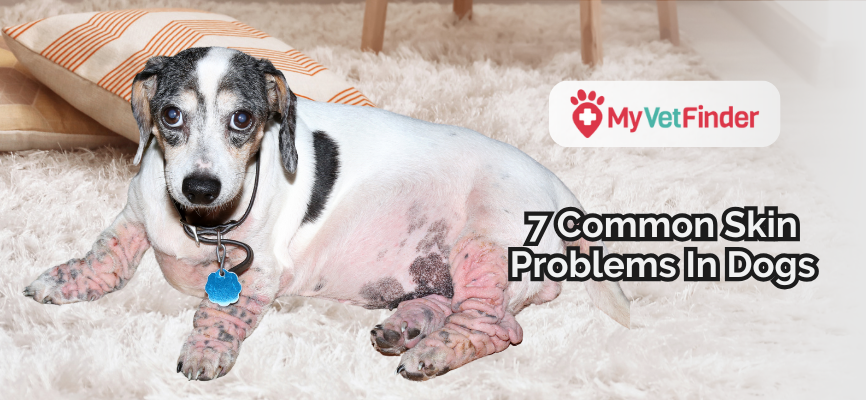
7 Common Skin Problems In Dogs

Have you noticed your dog scratching, biting, or licking excessively?
Dog scratching can be a common thing, but fur parents should pay attention if it becomes frequent or if it appears to hurt their pet. If so, then the behaviors might indicate a skin problem, which is one of the most common health issues for dogs.
Although skin conditions can significantly impact your dog's comfort and quality of life, early intervention can treat many of them effectively. In this article, we will explore seven common skin problems in dogs, along with their symptoms, causes, and effective treatments.
7 Common Skin Problems in Dogs
Many skin conditions are treatable, and prompt action can prevent further complications, including infections. Knowing the most common skin problems in dogs can help fur parents identify potential health issues early, ensuring their fur baby’s comfort and well-being above all else.
Below are 7 common skin problems in dogs to look out for.
1. Canine Atopic Dermatitis
Atopic dermatitis is a common allergic skin condition that leads to intense itching, hair loss, and skin irritation. Dogs suffering from this condition typically display red, inflamed patches of skin, hair loss, and scabs. They may scratch, lick, and bite excessively, often rubbing against objects to alleviate discomfort.
-
Possible Causes: Genetic predisposition, environmental allergens (such as pollen or dust mites), and flea infestations.
-
Home Treatments: Oatmeal baths, coconut oil, and anti-itch creams can help soothe the discomfort.
-
When to Seek Medical Help: If symptoms persist for more than a few days or if secondary infections develop.
-
Treatments/Medication: Antihistamines, steroids, immunotherapy, and topical treatments are commonly prescribed, along with flea control.
2. Folliculitis
Image Credit: Whole Dog Journal
Folliculitis occurs when hair follicles become inflamed, typically due to bacterial infections. It causes red bumps, scabs, and crusty areas around hair follicles, often leading to hair loss. Dogs may lick, chew, or scratch the affected areas, exacerbating the irritation.
-
Possible Causes: Bacterial infections (often Staphylococcus), fungal infections, trauma, or parasites.
-
Home Treatments: Gently cleaning the skin with antibacterial soap or antiseptic wipes.
-
When to Seek Medical Help: If the condition spreads or doesn’t improve with basic care.
-
Treatments/Medication: Antibiotics (topical or oral), antifungals, antipruritics, and anti-inflammatory treatments.
3. Mange
Microscopic mites infest a dog's skin to cause mange, which causes irritation, hair loss, and intense itching. The affected areas often display bald patches, red, inflamed skin, scabs, and crusts. Dogs will often scratch, rub, or bite these areas to relieve discomfort.
-
Possible Causes: Demodex mites (demodectic mange), Sarcoptes mites (sarcoptic mange), and Cheyletiella mites.
-
Home Treatments: Flea control and regular bathing.
-
When to Seek Medical Help: If severe itching, widespread lesions, or secondary infections occur.
-
Treatments/Medication: Topical or oral antiparasitic treatments, medicated baths, and corticosteroids for inflammation.
4. Seborrhea
Image Credit: Puainta
Seborrhea causes excessive oil production or flaky skin, leading to dry, scaly patches or greasy, oily spots on the skin. The condition may result in skin discomfort, prompting the dog to scratch or lick affected areas.
-
Possible Causes: Hormonal imbalances, allergies, infections, or genetic factors.
-
Home Treatments: Medicated shampoos designed for dry or greasy skin.
-
When to Seek Medical Help: If symptoms persist or worsen.
-
Treatments/Medication: Medicated shampoos, oral medications, and topical treatments.
5. Ticks
Ticks are external parasites that latch onto a dog’s skin and feed on its blood, causing irritation and potentially transmitting diseases like Lyme disease. Ticks often appear as small, round bumps or raised areas where they attach themselves to the skin. Dogs may scratch or bite the tick site to remove the parasite.
-
Possible Causes: Tick exposure, especially in wooded or grassy areas.
-
Home Treatments: Tick removers and tick-repellent collars or topical treatments.
-
When to Seek Medical Help: If symptoms of tick-borne diseases, such as fever or joint pain, appear.
-
Treatments/Medication: Tick preventatives and oral or topical medications for tick removal.
6. Ringworm
Image from Supertails
Dogs can contract ringworm, a fungal infection that can spread to humans. It causes hair loss, scaly patches, and skin irritation, typically appearing as round, red, scaly areas with darker edges. Dogs may scratch or lick the affected areas, although it’s not always itchy.
-
Possible Causes: Fungal dermatophytes, transmission from other animals or humans.
-
Home Treatments: Antifungal creams or shampoos for mild cases.
-
When to Seek Medical Help: If the condition spreads or does not improve.
-
Treatments/Medication: Oral antifungal medications, topical antifungals, and medicated baths.
7. Food Allergies
Food allergies in dogs can cause skin problems such as itching, redness, and chronic ear infections. The skin may appear red and irritated, with bald patches and inflamed ears. Dogs may scratch excessively, chew on their paws, or lick affected areas to relieve itching.
-
Possible Causes: Allergic reactions to specific ingredients in food, such as beef, chicken, or soy.
-
Home Treatments: Special hypoallergenic diets and food trials to identify allergens.
-
When to Seek Medical Help: If symptoms persist despite diet changes or if gastrointestinal issues occur.
-
Treatments/Medication: Food trials, antihistamines, steroids, and medications to manage itching.
Prioritize Your Dog's Skin Health for a Happier Life
Skin problems in dogs are common, but with early detection and the right treatment, most conditions can be managed effectively. If your dog is showing any signs of skin discomfort, it's essential to consult a veterinarian for proper diagnosis and treatment.
Early intervention can prevent complications and ensure a happier, healthier pet. Maintaining your dog's skin health is crucial for their overall well-being as a responsible pet owner.
Recent

June 30, 2025

June 24, 2025

June 18, 2025

May 09, 2025

May 02, 2025

